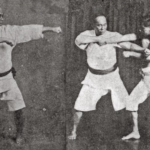We have already talked here about several characteristics of old style karate and about several of its differences in relation to modern karate. But one question remains: was ancient karate passed down through the generations without the use of specific terms to refer to these characteristics? The truth is that old style karate also had a specific terminology to refer to much of what was taught and practiced. And surprisingly, there is a wealth of technical detail among the (relatively) few documents that were written about ancient karate (in the early decades of the 20th century), and in the traditional oral teachings (kuden 口伝) that were passed down to practitioners of the modern era of karate, many of these teachings having been later recorded in books or articles.
Before delving into the technical terminology that I’ve selected for this article, it’s important to note that the suffix “te” 手 (tī/dī in Uchināguchi) used historically in karate has a broad meaning, not just referring to the literal translation “hand”, but also to fighting techniques in general. So, when reading the translation “hand”, remember that it is to be interpreted in a broader sense. I also note that the exact meaning of some of the terms presented in the literature may be subject to a certain level of interpretation, and that some concepts are presented with different names by different authors/works. In this article, I tried to use the interpretations that reflect the integrality of my studies and my practical experience (including the actual fighting part), and I chose the terminology that maintained greater consistency so that the concepts were presented together. With that said, let’s start with one of the most essential technical concepts of ancient karate:
One first fundamental concept
- Kakete[1] 掛け手 (japanese) / kakidī 掛手, カキディー (Uchināguchi) – “Hooked/hanging [connected] hands”. Technical concept that refers to the connection between the karateka’s arm and the opponent’s arm. It is similar to the concept known in some Chinese martial arts as “bridge”. The essence of old style karate applications is the connection with the opponent’s body (close range fighting) and although contact between arms is not the only form of connection, this type of contact constitutes the most fundamental form.
Once having seen that this connection between karateka and opponent is fundamental for fighting in the art, we also observe that the karateka will often seek to establish and maintain this connection, that is, he will try to stick to the opponent’s body, in all possible and tactically advantageous ways. And any form of adherence between the karateka’s arms and the opponent’s can characterize what we call kakete. Let’s now get to know the concepts that describe the gripping methods typical of ancient karate:
Gripping methods
- Nigirite 握り手 (Japanese) – “Hand that takes with the fingers”. Gripping technique that involves grabbing small parts (hair, trachea, ears, muscles, testicles, etc.) of the opponent’s body with the fingers of the karateka’s hand, for squeezing or pulling.
- Tsukamite 掴み手 (Japanese) – “Hand that grabs”. Gripping technique where the karateka grabs the opponent’s arm/fist with a closed hand (like someone grabbing a stick).
- Kagite 鉤手 (Japanese) or kakete[2] 掛手, 掛け手 (Japanese) – “Hooking hand”. Gripping technique that involves maintaining contact with the opponent’s arm by placing it in the crook of the karateka’s wrist (making a kind of hook shape between the karateka’s hand and forearm).
- Sukuite 掬い手 (Japanese) – “Hand that scoops”. Gripping technique that involves maintaining contact with the opponent’s arm by placing it in the pit (inside) of the karateka’s elbow. The sukuite method is greatly enhanced when used in combination with kagite.
- Kakaete 抱え手 (Japanese) – “Hand that holds under the arm”. Gripping technique that involves trapping the arm of the opponent under the armpit of the karateka. Once again, it is common to combine this technique with the others described above.
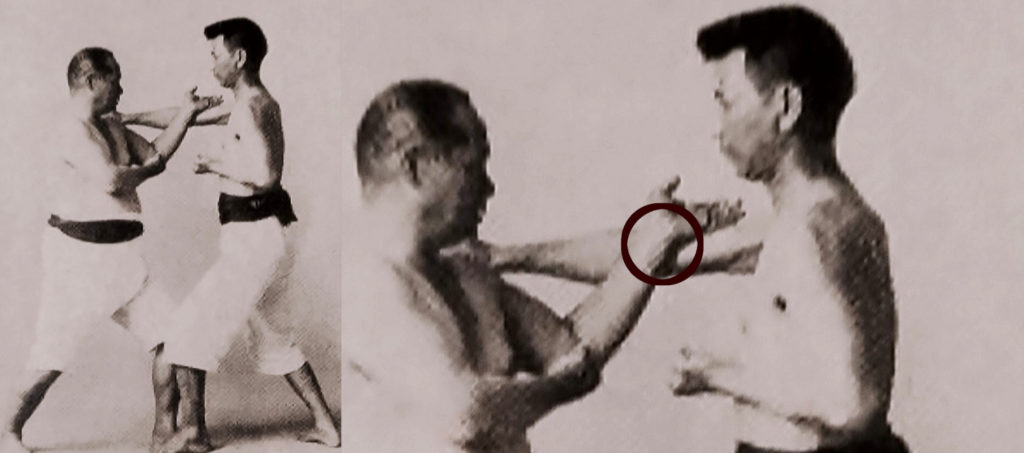
In addition to the methods seen above, another important form of adherence occurs when the karateka simply interposes a part of his arm against the opponent’s arm, in order to obstruct or redirect his movements. This method does not have a specific name, but can be described as a general form of kakete[1]. Due to the comparatively more precarious grip, this technique depends on the karateka’s great tactile sensitivity and instantaneous reaction capacity in relation to the opponent’s movement.
Note that all joints of the upper limbs (fingers, wrists, elbows and armpits) can perform gripping methods. And there are many other methods, such as using the legs, or even combining the pressure of the karateka’s hand or arm against other parts of his own body (chest, abdomen, legs, shoulders, neck, etc.), keeping the limb of the opponent in a kind of vise or pliers.

It is also worth noting that the above concepts are closely related to a fundamental principle of ancient karate known as muchimi ムチミ (Uchināguchi – possibly to be pronounced as mochimi in Japanese, and written as もち身, 餅身, 糯身 or 黐身). Even in Okinawa there are several different attempts at explaining the meaning of muchimi, but I find myself quite convinced as to what the real and exact meaning of this expression would be. We will talk more about this in a future article.
Control methods
Used in combination with gripping methods, there are also control methods, which manipulate the opponent’s body, forcing or preventing his movements in such a way as to provide advantages to the karateka during the fight.
- Hikite 引手 (Japanese) – “Pulling hand”. It is probably the most popular method among practitioners of practical karate, even though it is often not fully understood. This is the form of control where the karateka pulls the opponent’s arm and, when possible, twists his arm at the same time. It is a highly effective technique that helps throw the opponent off balance, exposes the flank of the opponent’s body and head to facilitate a decisive blow, and extends the opponent’s elbow to allow the execution of a joint lock. We can say that it is a form of control that directs the opponent’s limb “backwards” (that is, towards the karateka).

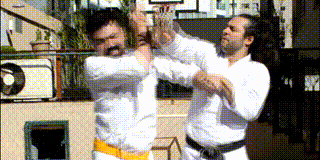
Right: Samir Berardo applying hikite during a close range confrontation exercise (kake kumite)
- Osaete 押さえ手 (Japanese) – “Pressing hand”. It is a form of control where the karateka pushes the opponent’s arm, usually against the latter’s own body, sometimes trapping one or even both of his arms, one over the other. We can say that this form of control directs the opponent’s limb “forward” (in the opposite direction of the karateka).
- Haraite 払い手 (Japanese) – “Sweeping hand”. It is a form of control where the karateka normally uses his hand or forearm to take the opponent’s limb out of the position it is in, not directing it backwards or forwards, but rather “away” from oneself (downwards, with the famous gedan-barai 下段払い; upwards, with the little-known jōdan-barai 上段払い; or towards the inside or outside).
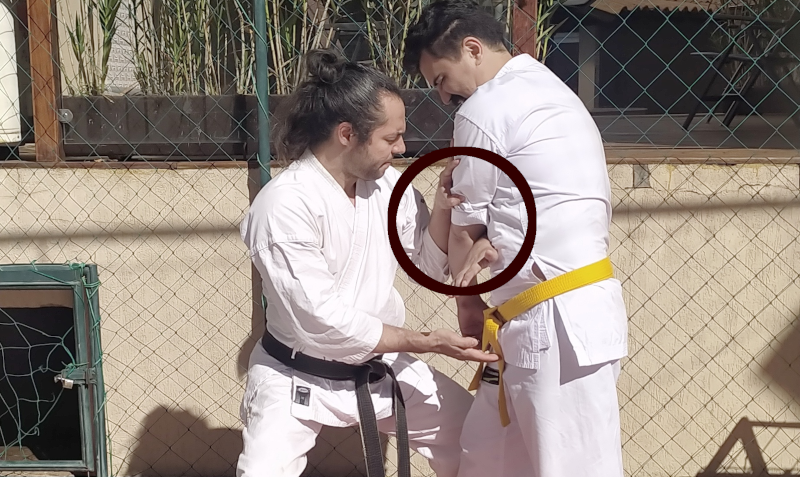
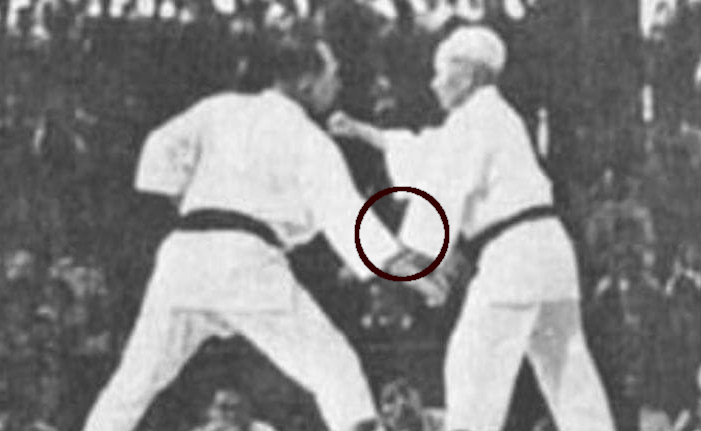
Right: Gichin Funakoshi demonstrating the haraite method of control (gedan-barai)
It is important to note once again that there are other forms of control used in practice, but which have not been given specific names in the literature (at least not among the works I studied). An example of an essential form that has not received a specific name consists of simply trapping the opponent’s arm using any gripping technique (tsukamite, kagite combined with sukuite or kakaete), thus preventing the movement of that arm (even if only temporarily). And, reinforcing once more, I remind you that all the techniques already described can and should be used in combination with each other during fighting.
With everything said above, two more supplementary concepts follow:
- Suemono ni suru 据物にする or suemono ni shite utsu 据物にして打つ (both expressions in Japanese) – “To transform into an ‘immovable object'” or “To transform into an ‘immovable object’ and attack”. It is a fundamental principle of ancient karate which means to make the opponent become similar to a suemono 据物 (“dead body used to test a sword”). That is, the concept refers to temporarily turning the opponent into an “immovable object” (through the application of gripping and control methods). By using the techniques described above, you will not necessarily keep the opponent completely immobilized, but you will be able to reduce his movement capacity and control the opponent’s limb or limbs for the time necessary to avoid an attack from him, or so that you can execute your own attack without the opponent being able to defend.
- Meotode 夫婦手 (Japanese) / mītudī ミートゥディ (Uchināguchi) – “Husband and wife hands”. There is a certain level of confusion about this concept, as some authors argue that it refers to a specific technique, a specific kamae 構え (“preparatory position”) or a broader tactical principle that permeates karate techniques altogether. It may even be the case that the same name was actually used with more than one meaning. Honestly, I don’t believe in the idea that meotode refers to a specific technique or set of techniques. Regarding the idea of kamae, it is a fact that there existed in ancient karate (and to some extent in modern Okinawan karate) a specific position to initiate fighting practices (at close range or even at long distance), and it seems reasonable to call this position meotode-no-kamae 夫婦手の構え, as some authors do. Think of it as an Okinawan version of the guard used in ancient bare-knuckle boxing.

With all that said, the meaning that I consider the most important for the concept of meotode is in the form of the tactical principle that says that both hands of the karateka must act in a simultaneous, harmonic and complementary way (as expected of a married couple — that’s why , “husband and wife hands”). Thus, while one hand is attacking, the other can be defending, removing or stopping the opponent’s arm to prevent his defense, or even immobilizing his arm to avoid a simultaneous counterattack. With this, the relationship between meotode and the gripping and control methods already seen above is evident (you can use gripping and control methods with one arm while performing another function — attack or defense — with the other arm). Naturally, it is also possible to use meotode by attacking with both hands at the same time, whether with impact strikes, kyūsho, joint locks or throws. And it is also possible to use both hands to control the opponent while the karateka attacks with the legs.
An important issue of the tactical principle of meotode is that it dispels the mistaken idea that the karateka performs his techniques with one hand while keeping the other on his waist (normally called hikite), without employing the latter more actively (some say that the hand on the waist is used to add power to the movements, which is an absolute technical, tactical and historical mistake). This hand mistakenly placed on the waist without grabbing anything (when it should actually be grabbing, pulling and twisting the opponent’s arm — the true hikite and an actual application of meotode) was expressly criticized by master Chōki Motobu and called shite 死手 (“dead hand”) .


Right: Shinpan Gusukuma applies meotode by grabbing with both hands while kicking the opponent
And now let’s move on to other concepts that do not specifically refer to gripping or controlling opponent, but are related to what we’ve already seen above:
A few more related fundamental concepts
- Kakie カキエ (uchināguchi), probably also spelled/spelled in Japanese as kakeai 掛合 (“meeting/harmony of kake” — some Japanese actually do spell kakie that way). Set of partner exercises, with arms in kakete[1], aimed at developing structural alignment, grip, tactile sensitivity, reaction time and other technical aspects. We have already talked a little more about this in a previous article. There are also records that define kakie/kakeai as the technical quality of the karateka to maintain contact with the opponent’s body, react appropriately to that contact and flow naturally from one technique to another. Some authors also consider kakete[1] and kakie as the same thing, but there are several reasons to treat them as different, albeit closely related, concepts.

- Kumite 組手 (Japanese) – “‘Entangled’/ ‘grappling’ hands”. General expression to refer to the various forms of “fighting” exercise practiced in karate. Although the expression “kumite” is nowadays strongly associated with modern forms of confrontational exercise (such as shiai kumite 試合組手, jiyū kumite 自由組手, etc.), it is also possible to use the expression to refer to more typical forms of confrontation of old style karate, as we will see below.
- Kake kumite 掛け組手 (Japanese) – “Kumite by kake”. Type of kumite practiced at close range, with continuous contact between participants. Historically practiced in Ryūkyū/Okinawa, and reconstructed and widely practiced within Muidokan. There are several references to kake kumite in historical records, indicating that it was an indispensable practice in the original Ryūkyū karate training. During kake kumite, practitioners have the best opportunity to perform actual applications of karate kata (including the gripping and control methods described above).
- Kakedameshi 掛け試し (Japanese) / kakidamishi カキダミシ (Uchināguchi) – “Challenge/test by kake [kake kumite]”. The translation is self-explanatory. Also practiced historically in Ryūkyū/Okinawa. Some authors treat kakedameshi and kake kumite as the same thing, but it makes sense to treat kakedameshi as a particular form of kake kumite, that is, it is specifically about kake kumite practiced when a karateka seeks to test his skills against another karateka (and not, for example, for the sole purpose of training, when the exercise could even be semi-collaborative).
For more details specifically on kake kumite and kakedameshi, I recommend reading the most thorough and best article ever written on the subject, authored by Muidokan member Bruno Chagas and which can be read on the Muidokan page here, or in the original blog post by the author, here.
To close our article, I invite the reader to also check out the video below with an example of kake kumite training, where I demonstrate in practice several of the concepts seen in this article. If you’d like to see more of these concepts in action, be sure to also check out our videos page here (and subscribe to my YouTube channel here).
Bibliography
CHAGAS, Bruno. Kake-kumite/Kakedameshi: A forma Original de Confronto Livre do Karate. Puro Karate, 2021. Retrieved from: <https://purokarate.com.br/2021/08/31/artigo-kake-kumite-kakedameshi-a-forma-original-de-confronto-livre-do-karate/>. Last accessed: February 22, 2023.
DUDUKCHAN, Igor. Traditional Wing Chun: The Branch of Great Master Yip Man. Independently published, 2017.
FUNAKOSHI, Gichin. Karate dō Kyōhan: Master Text for the Way of the Empty Hand. Neptune Publications, 2005.
FUNAKOSHI, Gichin. Karate dō Kyōhan: The Master Text. Kodansha USA, 2012.
FUNAKOSHI, Gichin. Karate: Ryūkyū Kenpō. Tokyo Ko Bun Do Books, 1922.
HIGAKI, Gennosuke. Hidden Karate: The True Bunkai For Heian Katas And Naihanchi. Champ: 2006.
ITOMAN, Morinobu. The Study of China Hand Techniques. Kowakan Karatedo Ltd., 2013
MABUNI, Kenwa; NAKASONE, Genwa. Invitación Al Karate-do. Miraguano Ediciones, 2019.
MABUNI, Kenwa; NAKASONE, Genwa. Kōbō Kenpō Karate-dō Nyūmon. Tokyo Kyobun-sha, 1938.
MCCARTHY, Patrick. Shigekazu Kanzaki Interview. IRKRS, 2001.
MCKENNA, Mario. Practical Strategies in Old Okinawa Karate-do. Kowakan, 2015. Retrieved from: <https://web.archive.org/web/20150926024711/http://www.kowakan.com/okinawa-karate-do/>. Last accessed: February 22, 2023.
MIYAZATO, Ei’Ichi. Okinawa Den Goju Ryu Karate-Do. Naha: Okinawa Goju Ryu Karate-do So Honbu Jundokan, 2005.
MOTOBU, Choki. Karate: My Art. 2nd Edition. IRKRS, 2006.
MOTOBU, Choki. Watashi no Karate-jutsu. Published by the author, 1932.
MOTOBU, Naoki. 夫婦手. Motobu-ryu Blog, 2016. Retrieved from: <https://ameblo.jp/motoburyu/entry-12141491151.html>. Last accessed: February 22, 2023.
MOTOBU, Naoki. Kakedameshi. Motobu-ryu Blog, 2020. Retrieved from: <https://ameblo.jp/motoburyu/entry-12589792105.html>. Last accessed: February 22, 2023.
MOTOBU, Naoki. Records about Kakidī before WWII. Motobu-ryu Blog, 2020. Retrieved from: <https://ameblo.jp/motoburyu/entry-12616358770.html>. Last accessed: February 22, 2023.
MOTOBU-RYU. 掛け手. Motobu-ryu, 2007. Retrieved from: <https://www.motobu-ryu.org/本部拳法/本部拳法の技術体系/掛け手/>. Last accessed: February 22, 2023.
QUAST, Andreas. A Study on Okinawan Karate Kata Names. Ryūkyū Bukei 琉球武芸, 2020. Retrieved from: <https://ryukyu-bugei.com/?p=8520>. Last accessed: February 22, 2023.
QUAST, Andreas. Muchimi. Ryūkyū Bukei 琉球武芸, 2015. Retrieved from: <https://ryukyu-bugei.com/?p=4809>. Last accessed: February 22, 2023.
RyuKyu Kingdom Sui-Di Bujutsu 琉球王朝首里手武術 Authentic Okinawan Karate, 2019. Retrieved from: <https://www.facebook.com/watch/?v=2428651900745307>. Last accessed: February 22, 2023.
WIKIPEDIA. 試し斬り. Wikipedia, 2023. Retrieved from: <https://ja.m.wikipedia.org/wiki/試し斬り>. Last accessed: February 22, 2023.
YOKOTA, Kousaku. Karatedo Quantum Leap. Azami Press, 2018.


